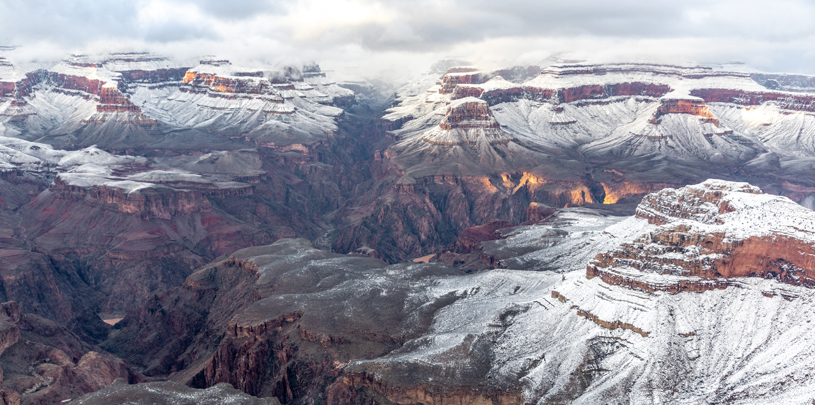
 by Roger Clark, Grand Canyon Director
by Roger Clark, Grand Canyon Director
Grand Canyon National Park turns 100 years old today, February 26, 2019. What better way to commemorate the milestone than with a commitment to better protect our natural wonder?
Today, Arizona Rep. Raúl Grijalva introduced the Grand Canyon Centennial Protection Act, a piece of legislation aimed at protecting 1 million acres of public lands adjacent to Grand Canyon National Park from uranium mining.
The bottom line is that mining uranium near the Grand Canyon does more harm than good, it doesn’t serve the public interest, and we need to draw the line here...
We can’t undo the toxic legacy left behind by the park’s first century, but we can prevent new contamination in its second.
Shocking, we know. Most park visitors are blissfully unaware that a uranium mine stood at Maricopa Point in the 1950s, that water downstream is radioactive, and that uranium mines continue operating outside park boundaries today. In fact, the uranium frenzy around the canyon reached such heights that, in 2012, the interior secretary enacted a 20-year "mineral withdrawal" — a temporary ban on new mining claims (which, at the time, numbered in the thousands).
“This toxic legacy is present all around us. From the Orphan Mine, Canyon Mine, the mines on the North Rim, and the hundreds of abandoned mines on the Navajo Nation, we know how uranium affects the land, air, and waterways. So why should we continue to allow the poisoning of the places we have left?” asks Sarana Riggs.
The Grand Canyon Centennial Protection Act would make the 2012 temporary ban permanent, which would eliminate speculative mining claims that mining companies and individuals have staked on public lands without having made a valid discovery of minerals. As of February 2018, there were over 800 active mining claims in the ban area. The Act would also prevent companies and individuals from staking new claims, although prior claims with valid existing rights could be developed.

This legislation is the most recent in a string of efforts to stop mining in the region, starting in 1893 when President Benjamin Harrison banned mining on 1.8 million acres in and around the Grand Canyon. The Navajo Nation banned uranium mining in 2005, and the Hualapai and Havasupai tribes also prohibit uranium mining on their lands adjacent to Grand Canyon National Park.
A broad-based and growing coalition supports the Grand Canyon Centennial Protection Act. Last weekend, more than 100 people joined Rep. Grijalva at the legislation announcement celebration, including the bill’s co-sponsor, Rep. Tom O’Halleran, Native leaders, and others.
We are just following in our ancestors' footsteps to protect this canyon. Please stand with us. Today is a very important day, a historical day, as we continue to work together to stop uranium mining in the canyon forever. Forever.”
— Carletta Tilousi, Havasupai Tribal Council
"The legacy of uranium mining has devastated the people and the land, and continues to destroy the land and lives of Hopisinom, Native Americans, and Americans alike," said Clark Tenakhongva, vice chairman of the Hopi Tribe. "If Americans are to live together in America in the 21st Century, we must call together for another way of living."
 Rep. Grijalva with tribal leaders in support of the Grand Canyon Centennial Protection Act. AMY S. MARTIN
Rep. Grijalva with tribal leaders in support of the Grand Canyon Centennial Protection Act. AMY S. MARTIN
Ethan Aumack, executive director of the Grand Canyon Trust said, "It is truly an honor to gather together with leaders from the Havasupai, Hualapai, Hopi, Navajo, and other Native nations, with members of Congress, county and city officials, conservation groups, businesses, hunters and anglers, and people from across our state and beyond who care deeply about this place. We have the opportunity to change the course of the Grand Canyon’s next 100 years."
A bipartisan poll of Arizona voters found that three in five want to continue the existing ban on new uranium mining on public lands next to Grand Canyon National Park.
A path forward
The bill closes the door on uranium mining within waterways draining directly into the Grand Canyon, but it’s not an easy path ahead.
As the chairman of the House Committee on Natural Resources, Rep. Grijalva will convene congressional hearings on the legislation during upcoming months. The U.S. House of Representatives could approve it within a year.
A companion bill will also need to be introduced in the Senate. Passage will likely require leadership from both of Arizona’s senators, paired with a strong show of bipartisan support, as Cindy McCain and Mark Udall suggest in their recent op-ed in the Washington Post.
The congressionally approved bill will also need a president who is willing to sign it.
Now is the time to protect the Grand Canyon’s sacred waters from permanent uranium-mining pollution. As we prepare to commemorate the 100th anniversary of Grand Canyon National Park, let’s remember that good stewardship, like good citizenship, strengthens and unites our nation.
Act now. Urge your senators to support, co-sponsor, and push for a committee hearing for S. 387, the Grand Canyon Protection Act, to permanently ban new uranium mines on public lands around the Grand Canyon.
80% of Arizona voters support Baaj Nwaavjo I'tah Kukveni National Monument, according to a new poll.
Read MoreThe Colorado River below Glen Canyon Dam is heating up. Find out why.
Read MoreGroundwater pumping at a uranium mine near the Grand Canyon will affect the canyon's springs, scientists says.
Read More